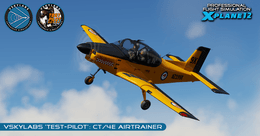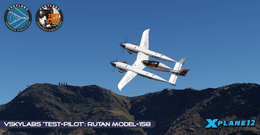$32.99
VSKYLABS Rutan LongEZ
The VSKYLABS Rutan LongEZ Project
JetManHuss - VSKYLABS (c) 2025 All Rights Reserved
A highly Realistic Flight Performance and Handling Simulation
of the Rutan LongEZ Aircraft
MINIMUM HARDWARE REQUIREMENTS FOR X-PLANE 12
Disk Space: 25GB
CPU: Intel Core i3, i5, i7, or i9 CPU with 4 or more cores, or AMD Ryzen 3, 5, 7 or 9.
(Those with other CPUs should try the demo before purchasing.)
Memory: 8 GB RAM
Video Card: a Vulkan 1.3-capable video card from NVIDIA or AMD with at least 2 GB VRAM
Note: Intel GPUs are not supported by X-Plane 12.
Separate native products for X-PLANE 12 and X-PLANE 11, for your selection.
The VSKYLABS Rutan LongEZ Project for X-Plane was developed with Mr. Burt Rutan's permission. However it is an independent VSKYLABS project which is not affiliated and/or endorsed with/by Mr. Burt Rutan. The project is based on the design of the Long-EZ (NR79RA) prototype.
Project Highlights:
The project is designed and engineered using the original 1980 'LONG-EZ Plans' and 'Pilot Operating Handbook' (N79RA). As a result, the VSKYLABS Rutan LongEZ Owner's manual is based on the real LongEZ owner's manual. The manual for the VSKYLABS LongEZ aircraft can be downloaded for free.
- Two variants included: Fully equipped Analog cockpit + 2x7" G1000 bundle cockpit.
- The core of the project is a superb flight dynamics model with authentic aircraft performance and handling characteristics.
- All LongEZ unique aerodynamics and systems are being simulated: Authentic handling, LongEZ stall characteristics, aircraft performance, Speed brakes (belly + Rudder brakes), On-ground retractable nose-gear and more!
- Designed for X-Plane's cutting edge flight model environment.
- Aeromatic propeller configuration is simulated (fully automatic variable pitch propeller).
- Highly detailed and animated aircraft model.
- AMAZING LongEZ VR experience! Highly detailed and functional 'VR-Ready' 3D cockpit environment.
- FMOD sounds engineered for enhanced flying experience, including high AoA buffeting, ground vibrations, wind noises and more!
- IFR capability (both analog and G1000 variants).
- Autopilot - Experimental/LSA grade autopilot is included in the analog cockpit variant, and fully-capable GA grade autopilot in the G1000 variant.
- Autoupdater based on the SkunkCrafts autoupdater (XP12 only) - all updates are being pushed smoothly without the need to re-download the entire base package (base package will be updated every once in a while to minimize the gap).
- Project under constant development!
Aircraft Design Notes
The VSKYLABS Rutan LongEZ Project aircraft design includes several improvements ("mods") which have been developed/adopted as the aircraft got mature. The following mods are included in the VSKYLABS Rutan LongEZ Project aircraft:
The 'High performance rudder mod': The initial design featured short rudders design, but soon after the first Long-EZ took flight, a few modifications were already underway to improve its design, including the extended rudders.
The 'Roncz canard mod': The original canard design of the LongEZ used the Glasgow University GU25-5(11)8 airfoil. The GU canard caused premature boundary layer transition under rain condition. The 'Roncz canard' which was designed by John Roncz used the Roncz R1145MS airfoil, and was developed in response to that problem, nicknamed "rain canards").
Aeromatic propeller configuration: The Aeromatic propeller is a variable pitch propeller having the same effect of a 'constant speed' propeller, except the fact that it is not using any governor, cockpit levers or special crankshafts. The propeller modulates itself based on airspeed other dynamic forces (fully automatic). Replicating the exact configuration for pitch change for the Aeromatic propeller is challenging with X-Plane's out-of-the-box propeller configuration features, but it was worth trying, and its performance is getting the VSKYLABS LongEZ to highly match its performance graphs (available at the real aircraft pilot operation handbook).
Landing/Taxi lights: Installing landing lights is a mod made by many EZ owners/builders. There are several options, including using the landing gears fairing. I've decided to cut a small compartment into the upper section of the nose cone. This place is allowing good angle settings for the landing/taxi lights and quite common in real-world LongEZ's.
Air-Brakes: The LongEZ is equipped with a belly-positioned air-brake which can be extracted during flight. In addition to that, an experimental implementation of Rudder-brakes is implemented in the VSKYLABS LongEZ. The pedals mechanism is allowing the use of differential rudder input, using the toe-brakes simultaneously. In this case, each rudder surface will be deployed "out", as if it is being used as a rudder...turning into a dual-rudder speed-brake. The rudder-brakes can be used in-flight, intuitively and accurately with the use of simple leg-work. This new feature is of course practical for pilots who are using rudder-pedals with toe-brakes hardware.
The Rutan LongEZ aircraft
The Rutan LongEZ is a high performance home built aircraft, designed by the aerospace legend Burt Rutan back in the 80's. Its compact external size results in superb performance and economy using low horsepower engines.
It features advanced aerodynamics and structure to provide good utility, economy, comfort, simplicity and flight safety. The aircraft uses one of two proven certified aircraft engines, the continental O-200/100 hp and the Lycoming O-235/115 hp (the VSKYLABS Rutan LongEZ is featuring the 115 hp engine).
It has an alternator powered electrical system and equipped with an electric engine starter. It’s cockpit layout is designed to compliment pilot work load with throttle, mixture, carburetor heat, pitch trim/landing controls on the left side console and a side stick controller on the right console. Seating provides correct armrest, lumbar, thigh and headrest support allowing “recliner chair” comfort which are typically not to be found in conventional aircraft seats. This configurations allows long, fatigue free flights.
The Long-EZ aircraft pioneered the use of the NASA developed winglet system which consists of an upper and lower cambered surface at each wing tip. These are designed to offset the wingtip vortex and reduce induced drag. The Long-EZ’s use of one way rudders in each winglet, makes use of the winglet camber to tailor the rudder forces. This results in low forces at low speeds where rudders are used, and higher forces at higher speeds where rudders are not needed.
Long-EZ interesting and useful resources
Disclaimer: VSKYLABS is not affiliated with any of the following web pages/people/organizations and is not responsible for the content within these sites.
BurtRutan.com:
- Burt Rutan's web pages - contains interesting articles, 'must read' PDF documents etc...: http://burtrutan.com
Burt Rutan Wikipedia page:
- The Aerospace Legend Burt Rutan Wikipedia page: https://en.wikipedia.org/wiki/Burt_Rutan
Rutan Long-EZ Wikipedia page:
- https://en.wikipedia.org/wiki/Rutan_Long-EZ
ez.org - A community of Rutan canard aircraft enthusiasts:
- Includes Forum, articles, links, various downloads (drawings, POH plans etc...): http://www.ez.org/
Long-EZ building blogs: Very interesting blogs showing the process of building a Long-EZ aircraft.
- http://www.aryjglantz.com/p/blog-page.html
- http://www.longezpush.com/
- http://www.longez209.com/
- http://longezproject.blogspot.co.il/
Pilot's Operating Handbook
<Included in the package>
Based on the Long-EZ First Edition May 1980 – Originally written and published by Rutan Aircraft Factory, Inc. Modified and published by VSKYLABS Aerospace Simulations
(Permission was granted)
Update Log
VSKYLABS Rutan LongEZ Project
JetManHuss - VSKYLABS (c) 2024 All Rights Reserved
XP12 - v4.2e (10th July 2023):
- G1000 variant - (now) disabled the Garmin ESP/USP system (autopilot stability and underspeed protections) which was enabled unintentionally during one of the XP12 default update process.
XP12 - v4.2c (18th February 2023):
- Paint-Kit was added into the project (PAINT-KIT folder).
XP12 - v4.2 (4th December 2022):
- Interior lighting system reset and retuned to comply with the modified X-Plane 12.00r1+ lighting engine.
- Analog cockpit modifications: new artificial horizon, new dual-system altimeter, improved instruments texture and PBR setup.
XP12 - v4.1 (23th November 2022):
- Updater software replaced - from STMA to SkunkCrafts.
XP12 v4.0 (September 2022):
- X-Plane 12 initial version release.
XP11 - v3.0 (15th September 2020):
- Additional variant was added to the package: A dual 7" G1000 glass cockpit LongEZ.
- Flight Dynamics: Fine tuning and final adaptation to the latest X-Plane's Experimental flight model.
- Aerodynamic Rudder-Brakes mod was implemented into the flight model.
- New Look and Feel: Extensive remodeling, re-texturing, re-mapping and enhancement of the entire project and its visual assets.
- Enhanced FMOD sound pack: To include high quality sound engineering and interactions from engine vibrations, high Angle of Attack buffeting and overall experience.
- VR interactivity tuneups.
XP11 - v2.0c (8th April 2020):
- Flight Dynamics:
- Engine oil temp and CHT temps tuneup with the focus on prolonged climbing.
- Differential braking is a bit less sensitive now (more rudder input is needed in case of using a twist/rudder joystick).
XP11 - v2.0 (30th March 2020):
- Flight Dynamics:
- Extensive flight dynamics tuneup for the Aeromatic propeller simulation.
- Performance and handling characteristics tuneup.
- External luggage pods are now affecting overall drag when placed/removed.
- External luggage pods may placed empty, or being loaded via the weight and balance setup. Weight and drag are differential, meaning that the pods may be installed while empty. This will add their drag to the overall drag without relation to their weight.
- Nosewheel castor limit was set to 65 degrees.
- 3D modeling improvements:
- Cockpit front panel remodeled with flushed-gauges and improved appearance.
- Old Bendix Transponder replaced with new custom GTX 330.
- Old GNS530 Remodeled and replaced with a new one.
- Interior composite structure remodeled, re-textured with higher resolution.
- Interior canopy element repainted.
- Aux Fuel Pump light bulb was replaced with a new one (3D modeled, LIT).
- Passenger is now visible from 1st person pilot view (can be removed by reducing it's weight via the payload setup).
- Pilot hands are on the controls, animated (visible from external view only)
- Systems, operation and interactions:
- Vertical Speed Indicator was re-calibrated.
- External luggage pods interaction is now different: Pods are visible by default, and by that are affecting drag. To remove/install them, simply click on the upper wing area in front of the fuel tank caps, or, assign Custom Slider#11 in X-Plane's assignments setup.
- New instrument gauges lighting for night-flying capability.
- Fuel tank selector is now switched to 'OFF' in cold and dark start.
- Weight and balance:
- The aircraft is now being loaded with two persons on board, and empty wing pods. to change these before flight, simply set the aircraft payload in X-Plane menu.
- General stuff:
- 'VSKYLABS Rutan LongEZ ESSENTIALS' instructions were added to the POH folder.
- The Red/White N79RA livery is now the default one. The Plain White paint was added as a separate livery.
XP11 - v1.6 (10th November 2019):
- Flight Dynamics Model was updated to X-Plane 11.40+ Experimental flight model.
XP11 - v1.5 (19th October 2019):
- STMA Autoupdater plugin was added as preparations for future updates.
XP11 - v1.4 (26th November 2018):
- Luggage pods are now removed, and will be added and visible only when the payload is set to exceed ~360 pounds (to include pilot/pilots and luggage), in the weight and balance settings in X-Plane.
- Engine power tuneups.
- High Angle of Attack handling tuneups.
- 3D modeling refinements.
XP11 - v1.3 (2nd November 2018):
- Fix to Joystick command issues with X-Plane 11.30b1+
XP11 - v1.2a (30th July 2018):
- Flight Dynamics model fix for engine exhaust point
XP11 - v1.2 (4th June 2018):
- Nose gear horn refinements and additional 100 knots IAS threshold limit.
- Turn and slip indicator adjustment.
- Magnetic compass - a fixed index needle was added.
- Aircraft category fixed to 'Experimental' only.
XP11 - v1.1 (10th May 2018):
- 3D Modeling - general:
- Cockpit floor rework (modeling and texture).
- Rudder pedals installation.
- Animated canopy strut.
- FMOD Sounds:
- Installation of the canopy-unlocked buzzer (warning when canopy is unlocked and throttle up to 90%).
- Touchdown sounds refinement and enhancement.
- Landing gears ride vibration effect.
- Liveries:
- Additional livery included.
- Virtual Reality:
- Refinements of some of the clickable visible green areas for more aesthetic appearance.
XP11 - v1.0 (May 8th 2018) - Initial Version Release.




